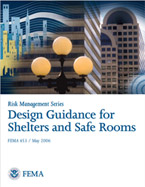 FEMA
FEMA
Sinopse: The attack against the Alfred P. Murrah Federal Office Building in Oklahoma City and the anthrax attacks in October 2001 made it clear that chemical, biological, radiological, and explosive (CBRE) attacks are a credible threat to our society. Such attacks can cause a large number of fatalities or injuries in high-occupancy buildings (e.g., school buildings, hospitals and other critical care facilities, nursing homes, day-care centers, sports venues, theaters, and commercial buildings) and residential neighborhoods.
This chapter discusses the potential manmade threats to which a shelter may be exposed and the level of protection (LOP) that may be assumed by building owners when deciding to build a shelter to support the preparedness objectives established in the National Preparedness Goal. This guidance complements other shelter publications such as the American Red Cross (ARC) 4496, Standards for Hurricane Evacuation Shelter Selection; FEMA 320, Taking Shelter From the Storm: Building a Safe Room Inside Your House; and FEMA 361, Design and Construction Guidance for Community Shelters. This manual presents information about the design and construction of shelters in the work place, home, or community building that will provide protection in response to the manmade CBRE threats as defined in the National Response Plan (NRP) and the National Planning Scenarios. As published in the National Preparedness Guidance (April 2005), the Federal interagency community developed 15 planning scenarios (the National Planning Scenarios or Scenarios) for use in national, Federal, state, and local homeland security preparedness activities. The National Planning Scenarios are planning tools and are representative of the range of potential terrorist attacks and natural disasters and the related impacts that face our nation. The scenarios establish the range of response requirements to facilitate preparedness planning.
The National Planning Scenarios describe the potential scope and magnitude of plausible major events that require coordination among various jurisdictions and levels of government and communities.
